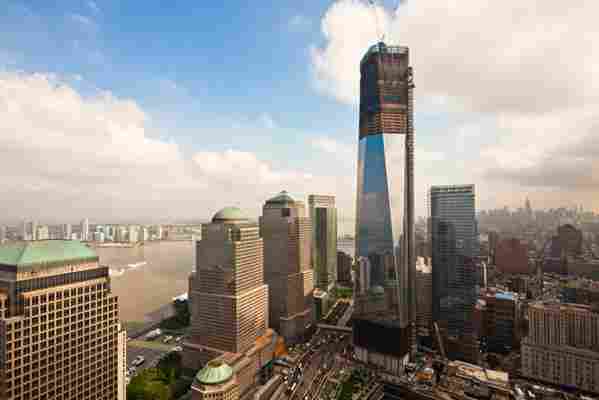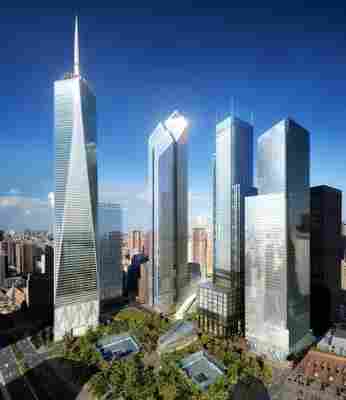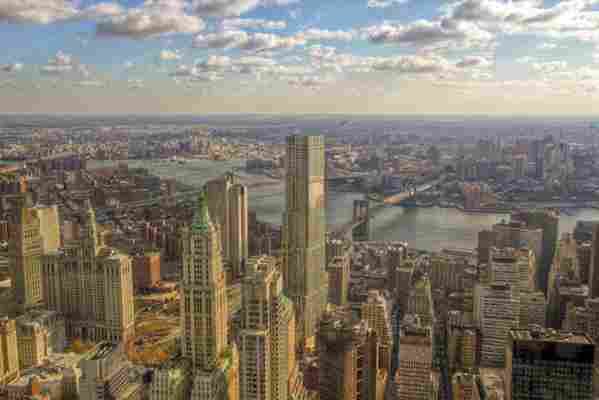Despite a decade of planning, the recent appearance of the new World Trade Center tower in the skyline of New York has been startling for many reasons, not the least of which being that the Port Authority of New York and New Jersey, the maker of bridges and tunnels and a few large buildings on historically less controversial sites, has managed to complete its construction (almost). This is a big accomplishment, even if you set aside all of the extraordinary considerations of this particular site and just consider Hudson River politics: imagine trying to get the respective governors of New York and New Jersey to agree on wallpaper, much less the western hemisphere’s largest office building (3 million square feet, to be exact), which is connected to many of the city’s subway lines as well as the Port Authority’s own trans-Hudson railway, commonly known as PATH.
There have been several visions for One World Trade Center, as it is formally known, beginning with Daniel Libeskind’s master plan, in 2003, when it was still referred to as the Freedom Tower, and then a controversial redesign by David Childs of Skidmore, Owings & Merrill—a redesign that for the most part survived yet another redesign, in 2005, after the New York Police Department weighed in and suggested the glass tower be further modified for safety. Since 2008 New Yorkers have seen an erector set–like spectacle when they look to the bottom of Manhattan Island: concrete follows the ascension of steel, at the pace of a floor a week.

But in these past few months, people in New York and nearby are at last getting a glimpse of what will be (by early 2014), and what is taking shape is a kind of classical obelisk, a monumental building. As little as five years ago, One World Trade Center was beginning to seem like a nearly $3.2 billion project to develop millions of square feet of office space that would not rent. ( The Wall Street Journal reported in January that the tower and its escalating costs earned the distinction of being the world’s most expensive building.) Suddenly, though, 1 WTC is filling up. (Condé Nast, *AD’*s parent company, is renting 1.2 million square feet.) Thanks in part to the tax breaks offered post–9/11, lower Manhattan is hot, with new residential buildings, new parks, new restaurants. And it’s not just hot in real-estate terms—it’s also the neighborhood with the highest number of newborns in New York City.

Almost forgotten in the midst of all this is the fact that the building that has emerged is one of the safest, technologically advanced, and environmentally sensitive in the world. “It has a concrete core, with very thick concrete walls,” says Eduardo del Valle, a design consultant for the Port Authority, which took control of the project in 2006. (Del Valle has a personal connection to the building—his first job as an architect was in an office on the 86th floor in the old World Trade Center’s south tower.) The three-foot concrete slabs are designed to withstand high winds and earthquakes; there’s also a rocklike anchor, referred to as the building’s “podium,” constructed to withstand other things. “The podium has some hefty blast-resistant walls at the base,” says del Valle. There are state-of-the-art fire-suppression systems, specially protected elevators (70 in total), and a separate, dedicated stairway for fire and safety personnel. “I can tell you that it may not be the tallest building in the world, but it is certainly the safest,” says del Valle.

It will also be one of the world’s greenest. Much of the materials used in its construction come from postindustrial recycled materials, and more than three-quarters of its waste will be recycled. Typically, glass walls are designed with iron in them, for structural stability, but the iron has been reduced here, to increase visibility and to allow as much daylight in as possible, reducing the need for electric illumination. “This glass will be clearer than the old World Trade Center’s,” del Valle says. “Compared to an older skyscraper, you will definitely see a clearer view.” There are also rainwater-collecting tanks that will help cool the tower and irrigate landscaping; such innovations will reduce water consumption by about 30 percent beyond what is saved in a typical water-efficient building in New York City.
Visually, the most striking feature of the interior is, without question, the cavernous lobby. Thanks to the boxlike structure of the podium, there is a soaring 60-foot ceiling—think of Radio City Music Hall’s theater, bathed in light.
Childs has stressed the point that the building is to both mark the site of the old towers and be a beacon for the future, like a lighthouse, and, partly as a result, the tower-topping spire will rise 408 feet, to bring the building to the historically symbolic height of 1,776 feet, making it the tallest in not only New York but also the nation. As a beacon, One World Trade Center is already working just fine—it’s visible from over 20 miles away, and people are looking up again. “I get e-mails all the time,” del Valle says, referring to acquaintances who live across the Hudson River in New Jersey. “Just yesterday I got a photo from a friend and it said, ‘Looking good.’”
